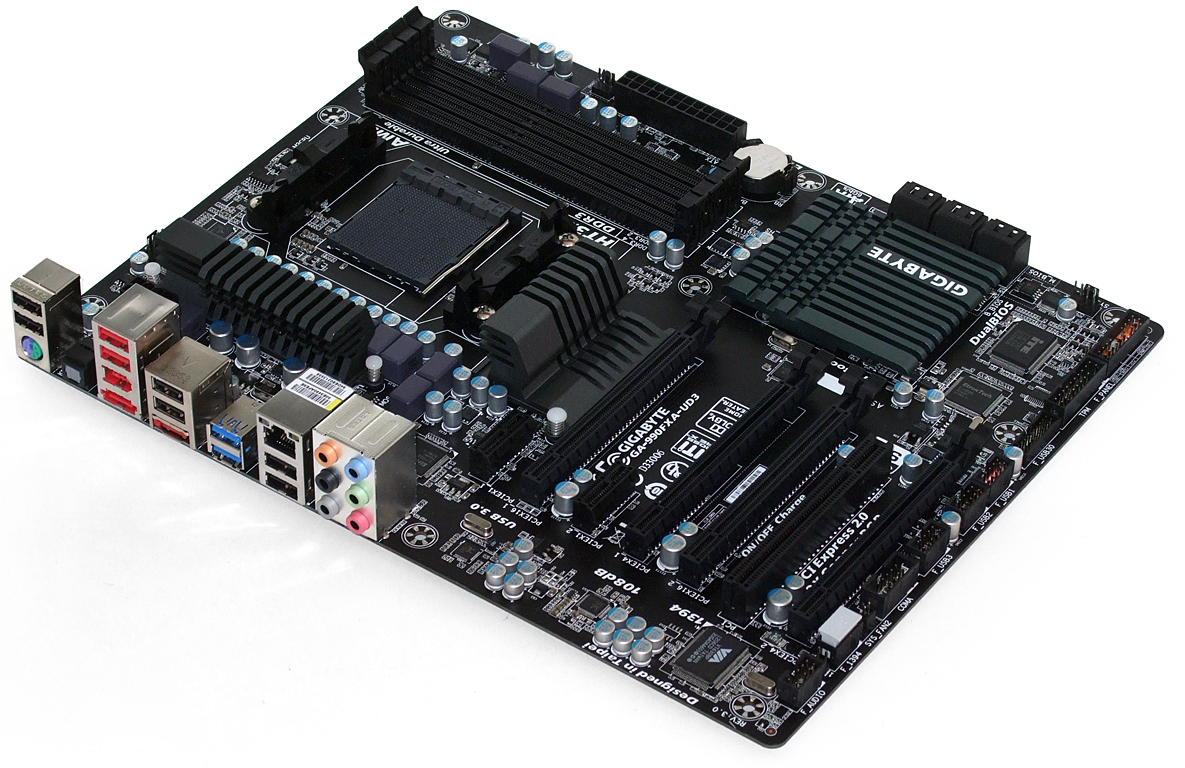Three AMD 990FX-Based Motherboards For Enthusiasts
AMD’s flagship FX-series processors squarely target enthusiasts with sub-$1,000 system budgets, and it's hard to get there with an expensive motherboard. We requested every vendor's top-value solution, and received three boards for your consideration.
Gigabyte 990FXA-UD3
For $5 less than its competition from Asus, Gigabyte’s 990FXA-UD3 provides similar hardware features. The firm loses the rarely-needed but somewhat-pricy USB Flashback processor, and instead adds a somewhat-outdated but less-costly FireWire controller.
Gigabyte doesn’t place one of its internal SATA ports on the upper half of the board to ease front-panel eSATA cable access, but instead puts both eSATA ports on the rear I/O panel. Buyers get the same total number of SATA ports, the same total number of USB 3.0 ports, and the same total number of USB 2.0 ports on both Gigabyte and Asus products (though only Asus claims UASP support under Windows 7).
Both similarly-priced, competing products offer the same PCIe x16 slot configuration, as both are designed primarily for two-way SLI. Both primary slots are permanently connected to 16 pathways each, and both secondary slots are permanently connected to four pathways each. Gigabyte adds an x1 slot above the top x16 slot, however, and uses a cut-away northbridge sink to allow installation of longer expansion cards in this location.
Gigabyte moves its CPU power connector behind the voltage regulator sink and turns it sideways, which could be a benefit or detriment, depending on case and cooler configurations. The latch on Asus’ top-edge connector faces upward, making it hard to reach in cases that rout its cable over the top edge of the motherboard tray, while Gigabyte’s alternative placement could be boxed in by rear-panel liquid cooling radiators, such as the Enermax ELC120 and Zalman LQ-320.
The 990FXA-UD3’s front-panel audio connector is found in the bottom-rear corner, where we're accustomed to finding it. But some cases occasionally enter the market with a cable that’s around half of an inch too short to reach that corner. Older cases might also have hard drive cages that block cable access to the forward-facing SATA ports. On the other hand, while a video card in the bottom slot might also block access to the front-panel USB 3.0 header, that problem is mostly theoretical on a board not practically designed for three-way CrossFire or SLI.
Four SATA cables, a single SLI bridge, and a case badge put Gigabyte’s 990FXA-UD3 installation kit on-par with its closest competitor, though the ends of Gigabyte’s cables are black. The badge might just be more important than the color of the cables, as it indicates that this board ships with Dolby Home Theater software. The software adds on-the-fly Dolby 5.1 digital encoding, multi-channel synthesized expansion, environmental correction, and various other audio manipulation technologies.
Get Tom's Hardware's best news and in-depth reviews, straight to your inbox.
-
designasaurus "if we diminished most of those power differences by not installing Asus' power management software at default settings, the company would have likely matched the performance of Gigabyte and ASRock."Reply
Don't speculate! Do the tests and add it to the article so we can see what the software packages are actually accomplishing! That's why I read your site, yeah? For hard info that I can't get myself. -
bgunner designasaurus"if we diminished most of those power differences by not installing Asus' power management software at default settings, the company would have likely matched the performance of Gigabyte and ASRock."Don't speculate! Do the tests and add it to the article so we can see what the software packages are actually accomplishing! That's why I read your site, yeah? For hard info that I can't get myself.I totally agree with this statement. The test should have been done and added into the article because this would of been a good representative of the value of the software. I would like to know for a fact if the software was a hindrance to the electrical efficiency of the Asus and Gigabye boards.Reply -
Crashman bgunnerI totally agree with this statement. The test should have been done and added into the article because this would of been a good representative of the value of the software. I would like to know for a fact if the software was a hindrance to the electrical efficiency of the Asus and Gigabye boards.At least the power was measured and mentioned, even if it didn't get into the chart.Reply
-
bit_user AMD's 890FX was an excellent low-cost server platform, in its day. Great I/O, tons of PCIe lanes, 6-channel SATA3, and ECC support. All with boards and CPUs in the desktop price range that were close to being performance competitive with Intel (when they were introduced, at least).Reply
Now, AMD is just slipping too far behind. Not just on the CPU front, but like how about some PCIe 3?
I'm waiting for 64-bit ARMs to hit the desktop. That's probably the next truly interesting thing on the horizon.
-
boulbox Reply10596062 said:Aren't the 990FX chipsets kind old?
Yes, but not a lot of new things need to be offered anyways. PCIe 3.0 is just a gimmick and doesn't really give much more performance over PCIe2 -
Crashman falchardAren't the 990FX chipsets kind old?990FX is AMD's current "high-end" chipset for enthusiast-level desktops. AMD occasionally releases new chips (look last fall) and motherboard companies keep updating their selection of products.Reply
Old chipset, recent boards, any questions?
-
darkchazz "Three AMD 990FX-Based Motherboards For Enthusiasts"Reply
I don't think enthusiasts would want to buy a slow CPU from AMD. -
Onus What did I miss? The ASRock has better features, including 3-way SLI, more USB3.0, an abundance of accessories, uses less power (the only positive efficiency), has higher performance, lower VRM temps; but BOTH of the other two got awards? I noted the comment about fluctuating prices, but on features alone ASRock looks like the winner. Surely it wasn't the slightly lower OC...Reply



